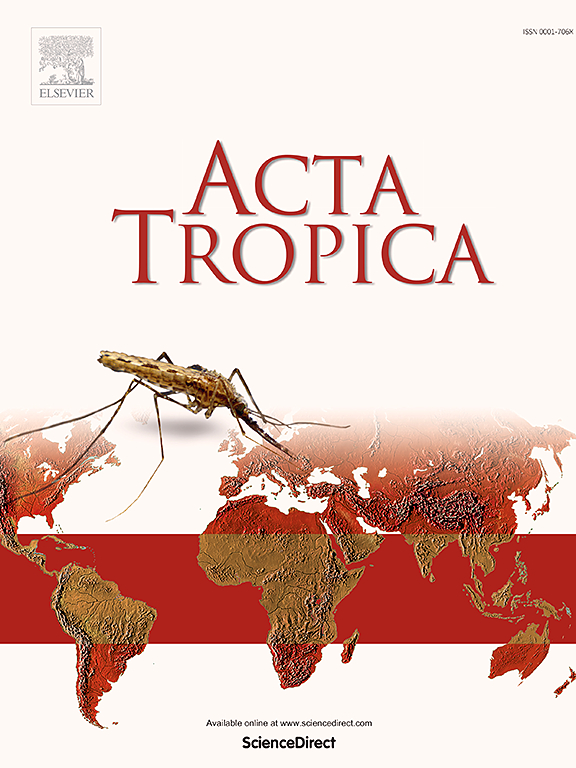蚤类(昆虫纲:管翅目)媒介细菌和寄生虫病原体的分子检测:首次报道基耶岛蚤中犬布氏弓形虫和伯氏弓形虫
IF 2.5
3区 医学
Q2 PARASITOLOGY
引用次数: 0
摘要
跳蚤是影响人类和动物的各种病原体的媒介。本研究旨在确定蚤类巴尔通体、立克次体、伯氏柯谢氏体和犬双螺旋虫的存在及其遗传多样性。在托卡特省4个区(Artova、Sulusaray、Yesilyurt和Central)的家畜(绵羊、山羊、狗和猫)身上采集了跳蚤。对蚤类进行形态鉴定,并按种类进行分类;为每个物种准备了一至五个标本池。从汇集的样本中提取基因组DNA,并通过pcr筛选细菌种类,包括伯纳氏梭菌、巴尔通体、立克次体和蠕虫,如犬疟原虫。阳性样本进行病原体鉴定测序,并进行生物信息学分析。345只蚤中,刺蚤99只,犬栉头螨48只,猫栉头螨198只。PCR结果显示,在70个蚤池中检测到12个池(11个刺激弓形虫池和1个猫弓形虫池)和3个池(1个猫弓形虫池、1个狗弓形虫池和1个刺激弓形虫池),分别检测到伯氏弓形虫和犬弓形虫。此外,所有蚤池均未检出立克次体和巴尔通体,测序结果证实存在伯纳蒂弓形虫和犬弓形虫。系统发育分析表明,我们分离的犬D。犬科犬基因型组。该分离株与巴西人血样本(JF970260)的同源性最高,分别为99.63%和99.81%。医学和兽医重要的跳蚤可以携带多种病原体,在“同一个健康”的概念下,未来对跳蚤传播病原体的研究对公共卫生至关重要。本文章由计算机程序翻译,如有差异,请以英文原文为准。
Molecular detection of bacterial and helminth pathogens in flea (Insecta: Siphonaptera) vectors: First report of D. caninum and C. burnetii in fleas from Türkiye
Fleas are vectors of various pathogens affecting humans and animals. This study aimed to determine the presence and genetic diversity of Bartonella spp., Rickettsia spp., Coxiella burnetii, and Dipylidium caninum in fleas. Fleas were collected from domestic animals (sheep, goat, dog, and cat) in four districts (Artova, Sulusaray, Yesilyurt, and Central) of Tokat province. The flea species were identified morphologically and then separated according to their species; pools of one to five specimens were prepared for each species. Genomic DNA from the pooled samples was extracted and screened by PCRs for bacterial species, including C. burnetii, Bartonella spp., Rickettsia spp., and also helminths such as D. caninum. Positive samples were sequenced for pathogen characterization, and bioinformatics analysis was performed. Of the 345 fleas identified, 99 were Pulex irritans, 48 were Ctenocephalides canis, and 198 were Ctenocephalides felis. PCR results revealed that C. burneti in 12 pools (11 pools from P. irritans and one pool from C. felis) and D. caninum in three pools (one pool from C. felis, C. canis, and P. irritans) from 70 flea pools were detected. Additionally, none of the flea pools were positive for Rickettsia spp. and Bartonella spp. The sequencing results confirmed the presence of C. burnetii and D. caninum. The phylogenetic analyses revealed that our D. caninum isolates belonged to the “D. caninum canine genotype” group. Our C. burnetii isolates obtained from P. irritans and C. felis pools showed the highest identity (99.63 % and 99.81 %, respectively) with the isolate detected in a human blood sample from Brazil (JF970260). Medically and veterinary important fleas can carry multiple pathogens, and future research on flea-borne pathogens is vital for public health in the “One Health” concept.
求助全文
通过发布文献求助,成功后即可免费获取论文全文。
去求助
来源期刊

Acta tropica
医学-寄生虫学
CiteScore
5.40
自引率
11.10%
发文量
383
审稿时长
37 days
期刊介绍:
Acta Tropica, is an international journal on infectious diseases that covers public health sciences and biomedical research with particular emphasis on topics relevant to human and animal health in the tropics and the subtropics.
 求助内容:
求助内容: 应助结果提醒方式:
应助结果提醒方式:


